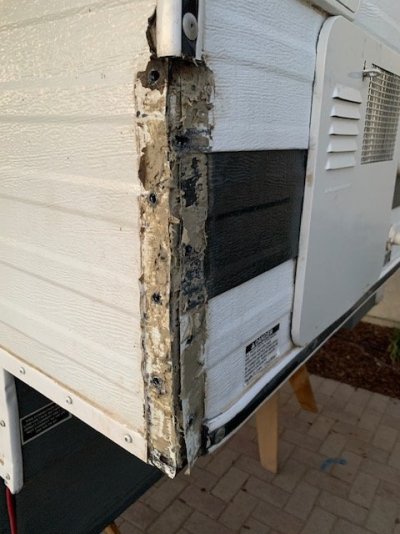Ruck_and_Roll
Senior Member
Hey all-
Looking for help on a new issue. I have a 2008 Hawk. I noticed a few screws loose on the jack mounting brackets which is resulting in the jacket brackets being pulled away from the camper under force. On my last time loading the camper I think had a little bit of user error and had some horizontal forces (in combination with using extension plates and casters), where the jack forces angled and weren't straight vertical, resulting in stress on the attachment points. Each of the attachment points appear to be ~1.5-2 in self tapping screws, There are 8 in total on each jacket bracket. . I've noticed some have been somewhat loose before. It seems like 4 of the screws have lost their "bite." Thinking some of of it could be due to some wood rot and wood stripping. Anyone have any ideas or suggestions? Obviously looking for a solution where I don't have to remove the outer skin or anything real intrusive. Just really looking to beef up the attachment between the jacket brackets and the camper. I am sure a new application of adhesive would be helpful as well.
Picture attached.
Best,
Luke
Looking for help on a new issue. I have a 2008 Hawk. I noticed a few screws loose on the jack mounting brackets which is resulting in the jacket brackets being pulled away from the camper under force. On my last time loading the camper I think had a little bit of user error and had some horizontal forces (in combination with using extension plates and casters), where the jack forces angled and weren't straight vertical, resulting in stress on the attachment points. Each of the attachment points appear to be ~1.5-2 in self tapping screws, There are 8 in total on each jacket bracket. . I've noticed some have been somewhat loose before. It seems like 4 of the screws have lost their "bite." Thinking some of of it could be due to some wood rot and wood stripping. Anyone have any ideas or suggestions? Obviously looking for a solution where I don't have to remove the outer skin or anything real intrusive. Just really looking to beef up the attachment between the jacket brackets and the camper. I am sure a new application of adhesive would be helpful as well.
Picture attached.
Best,
Luke

